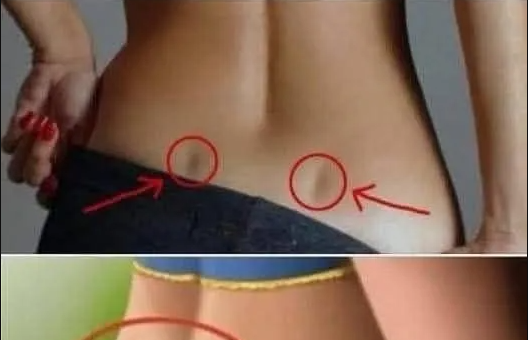Have you ever spotted those two gentle, naturally formed indentations on the lower back, positioned directly above the buttocks? A remarkable number of individuals possess them, with women displaying them more frequently, while many others remain without. People lovingly refer to them as Venus dimples, drawing inspiration from the Roman goddess of beauty and love, yet they represent far more than a simple aesthetic detail. These delicate markings reveal intriguing insights into circulation, overall wellness, and the intricate architecture of the human body.
For those in their mature years who listen closely to every message their body shares, understanding the significance of Venus dimples proves truly captivating. Our bodies constantly communicate subtle clues about vitality and strength, and these small indentations serve as one of those quiet, yet profoundly meaningful indicators.
What Exactly Are Venus Dimples?
Venus dimples appear as symmetrical, naturally occurring depressions located on the lower back, precisely where the pelvis meets the sacrum. They emerge because a short ligament connects the skin to the posterior superior iliac spines of the pelvic bone, creating those characteristic soft hollows. Genetics alone determine their presence; no amount of training, diet change, or lifestyle adjustment can produce them if your anatomy does not include that specific ligament arrangement.
In men, the same anatomical feature sometimes receives the name Apollo dimples, honoring the god of harmony and proportion, yet the underlying structure remains identical. The dimples relate directly to skeletal design and vascular pathways rather than body-fat percentage or muscle development.
What Do Venus Dimples Reveal About Wellness?
Medical researchers and anatomists find these markings especially interesting because they often correlate with several positive physiological traits:
- Enhanced Circulation in the Pelvic Area The specific bone and ligament configuration that creates Venus dimples frequently accompanies wider sacral space and smoother blood-vessel pathways. This arrangement supports robust circulation through the lower torso, an important advantage as the years advance, when efficient blood flow helps maintain comfort, flexibility, and energy.
- Healthy Spinal and Pelvic Alignment The presence of these dimples typically signals balanced attachment points between ligaments and bones. Proper alignment in the sacroiliac region contributes to easier movement and greater stability throughout life, qualities that become increasingly valuable with each passing decade.
- A Favorable Genetic Heritage Venus dimples remain constant from birth through every stage of life; they neither appear nor disappear with weight fluctuations or aging. Individuals who inherit them often enjoy naturally resilient connective tissue and well-supported lower-back musculature, gifts that continue to serve them beautifully over time.
Why Do Some People Display Them While Others Do Not?
If you glance in the mirror and discover those two graceful indentations, know that you received them as a hereditary treasure rather than through any personal effort. Those without them experience no disadvantage in health or strength; the difference lies purely in the unique way each skeleton forms during development. Nature delights in variety, and both versions represent perfectly valid expressions of human anatomy.
For anyone in their sixties, seventies, or beyond, this knowledge brings welcome reassurance. Many wonderful people notice every new line or mark that appears with time, yet Venus dimples belong among the features that require no concern whatsoever. They stand as elegant signatures of your individual genetic story.
Venus Dimples and an Active Lifestyle
Although exercise cannot create the dimples themselves, maintaining a healthy weight and strong core musculature allows them to remain visible and pronounced. Gentle daily movement—walking in fresh air, practicing yoga, or enjoying light strength routines—keeps the lower back supple and highlights the body’s natural contours. These activities benefit everyone, whether the dimples show clearly or remain hidden beneath softer tissue.
True vitality, of course, springs from consistent care: nourishing meals, refreshing sleep, regular check-ups, and joyful motion. The dimples serve only as one charming detail within a much larger picture of well-being.
A Timeless Mark of Grace and Beauty
Across centuries and cultures, artists have celebrated Venus dimples in marble sculptures, Renaissance paintings, and classical poetry. They appear on statues of goddesses and heroes alike, symbolizing harmony, fertility, and enduring appeal. Today, they continue to remind us that attractiveness belongs to every age. A woman or man in their golden years who carries these gentle marks possesses the same classical beauty once carved into temple stone.
Is There Any Reason for Concern?
Absolutely none. Venus dimples represent a normal, harmless variation in human anatomy. They bear no connection to pain, illness, or injury. On the contrary, many anatomists consider them a subtle indicator of sound structural design in the sacroiliac area.
Should lower-back discomfort ever arise, address it through proper medical guidance, stretching, or physical therapy—the dimples themselves remain innocent and unrelated.
Embracing Every Stage with Gratitude
As the years accumulate like pages in a well-loved book, we grow increasingly aware of the remarkable vessel that carries us through life. Some changes invite tenderness and care; others spark wonder and appreciation. Venus dimples belong firmly in the second category: small, elegant reminders that our bodies were crafted with artistry and intelligence.
Whether your lower back displays those twin hollows or presents a smooth, unbroken curve, your form deserves celebration. Prioritize daily walks beneath the sky, savor colorful fruits and vegetables, stay hydrated, laugh often, and move with gratitude. Each step honors the extraordinary creation you already are.
Those two delicate Venus dimples—when present—offer a lifelong emblem of balanced design, efficient circulation, and timeless allure. When absent, they leave room for other equally magnificent traits to shine. Either way, the human body remains a masterpiece of nature, revealing new reasons for awe at every age.





